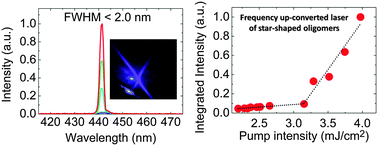Ultralow-threshold up-converted lasing in oligofluorenes with tailored strong nonlinear absorption†
Abstract
Nonlinear optical response in organic semiconductors has been an attractive property for many practical applications. For frequency up-converted lasers, to date, conjugated polymers, fluorescent dyes and small organic molecules have been proposed but their performances have been severely limited due to the difficulty in simultaneously achieving strong nonlinear optical response and high performance optical gain. In this work, we show that structurally designed truxene-based star-shaped oligofluorenes exhibit strong structure–property relationships enabling enhanced nonlinear optical response with favorable optical gain performance. As the number of fluorene repeat units in each arm is increased from 3 to 6, these molecules demonstrate a two-photon absorption cross-section as high as 2200 GM, which is comparable to that of linear conjugated polymers. Tailored truxene oligomers with six fluorene units in each arm (T6) show two-photon absorption pumped amplified spontaneous emission with a threshold as low as 2.43 mJ cm−2, which is better than that of the lowest reported threshold in organic semiconductors. Furthermore, we show a frequency up-converted laser using the newly designed and synthesized star-shaped oligomer T6 with a threshold as low as 3.1 mJ cm−2, which is more than an order of magnitude lower than that of any conjugated polymer. Thus, these oligomers with enhanced nonlinear optical properties are highly attractive for bio-integrated applications such as photodynamic therapy and in vivo bio-sensing.


 Please wait while we load your content...
Please wait while we load your content...